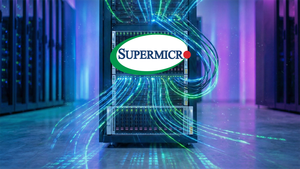
GSI Technology (NASDAQ: GSIT) experienced an extraordinary surge on Monday, October 20, 2025, as its stock price more than tripled, catapulting the company into the spotlight of the artificial intelligence sector. The monumental leap was triggered by the release of an independent study from Cornell University researchers, which unequivocally validated the groundbreaking capabilities of GSI Technology’s Associative Processing Unit (APU). The study highlighted the Gemini-I APU's ability to deliver GPU-level performance for critical AI workloads, particularly retrieval-augmented generation (RAG) tasks, while consuming a staggering 98% less energy than conventional GPUs. This independent endorsement has sent shockwaves through the tech industry, signaling a potential paradigm shift in energy-efficient AI processing.
Unpacking the Technical Marvel: Compute-in-Memory Redefines AI Efficiency
The Cornell University study served as a pivotal moment, offering concrete, third-party verification of GSI Technology’s innovative compute-in-memory architecture. The research specifically focused on the Gemini-I APU, demonstrating its comparable throughput to NVIDIA’s (NASDAQ: NVDA) A6000 GPU for demanding RAG applications. What truly set the Gemini-I apart, however, was its unparalleled energy efficiency. For large datasets, the APU consumed over 98% less power, addressing one of the most pressing challenges in scaling AI infrastructure: energy footprint and operational costs. Furthermore, the Gemini-I APU proved several times faster than standard CPUs in retrieval tasks, slashing total processing time by up to 80% across datasets ranging from 10GB to 200GB.
This compute-in-memory technology fundamentally differs from traditional Von Neumann architectures, which suffer from the 'memory wall' bottleneck – the constant movement of data between the processor and separate memory modules. GSI's APU integrates processing directly within the memory, enabling massive parallel in-memory computation. This approach drastically reduces data movement, latency, and power consumption, making it ideal for memory-intensive AI inference workloads. While existing technologies like GPUs excel at parallel processing, their high power draw and reliance on external memory interfaces limit their efficiency for certain applications, especially those requiring rapid, large-scale data retrieval and comparison. The initial reactions from the AI research community have been overwhelmingly positive, with many experts hailing the Cornell study as a game-changer that could accelerate the adoption of energy-efficient AI at the edge and in data centers. The validation underscores GSI's long-term vision for a more sustainable and scalable AI future.
Reshaping the AI Landscape: Impact on Tech Giants and Startups
The implications of GSI Technology’s (NASDAQ: GSIT) APU breakthrough are far-reaching, poised to reshape competitive dynamics across the AI landscape. While NVIDIA (NASDAQ: NVDA) currently dominates the AI hardware market with its powerful GPUs, GSI's APU directly challenges this stronghold in the crucial inference segment, particularly for memory-intensive workloads like Retrieval-Augmented Generation (RAG). The ability of the Gemini-I APU to match GPU-level throughput with an astounding 98% less energy consumption presents a formidable competitive threat, especially in scenarios where power efficiency and operational costs are paramount. This could compel NVIDIA to accelerate its own research and development into more energy-efficient inference solutions or compute-in-memory technologies to maintain its market leadership.
Major cloud service providers and AI developers—including Google (NASDAQ: GOOGL), Microsoft (NASDAQ: MSFT), and Amazon (NASDAQ: AMZN) through AWS—stand to benefit immensely from this innovation. These tech giants operate vast data centers that consume prodigious amounts of energy, and the APU offers a crucial pathway to drastically reduce the operational costs and environmental footprint of their AI inference workloads. For Google, the APU’s efficiency in retrieval tasks and its potential to enhance Large Language Models (LLMs) by minimizing hallucinations is highly relevant to its core search and AI initiatives. Similarly, Microsoft and Amazon could leverage the APU to provide more cost-effective and sustainable AI services to their cloud customers, particularly for applications requiring large-scale data retrieval and real-time inference, such as OpenSearch and neural search plugins.
Beyond the tech giants, the APU’s advantages in speed, efficiency, and programmability position it as a game-changer for Edge AI developers and manufacturers. Companies involved in robotics, autonomous vehicles, drones, and IoT devices will find the APU's low-latency, high-efficiency processing invaluable in power-constrained environments, enabling the deployment of more sophisticated AI at the edge. Furthermore, the defense and aerospace industries, which demand real-time, low-latency AI processing in challenging conditions for applications like satellite imaging and advanced threat detection, are also prime beneficiaries. This breakthrough has the potential to disrupt the estimated $100 billion AI inference market, shifting preferences from general-purpose GPUs towards specialized, power-efficient architectures and intensifying the industry's focus on sustainable AI solutions.
A New Era of Sustainable AI: Broader Significance and Historical Context
The wider significance of GSI Technology's (NASDAQ: GSIT) APU breakthrough extends far beyond a simple stock surge; it represents a crucial step in addressing some of the most pressing challenges in modern AI: energy consumption and data transfer bottlenecks. By integrating processing directly within Static Random Access Memory (SRAM), the APU's compute-in-memory architecture fundamentally alters how data is processed. This paradigm shift from traditional Von Neumann architectures, which suffer from the 'memory wall' bottleneck, offers a pathway to more sustainable and scalable AI. The dramatic energy savings—over 98% less power than a GPU for comparable RAG performance—are particularly impactful for enabling widespread Edge AI applications in power-constrained environments like robotics, drones, and IoT devices, and for significantly reducing the carbon footprint of massive data centers.
This innovation also holds the potential to revolutionize search and generative AI. The APU's ability to rapidly search billions of documents and retrieve relevant information in milliseconds makes it an ideal accelerator for vector search engines, a foundational component of modern Large Language Model (LLM) architectures like ChatGPT. By efficiently providing LLMs with pertinent, domain-specific data, the APU can help minimize hallucinations and deliver more personalized, accurate responses at a lower operational cost. Its impact can be compared to the shift towards GPUs for accelerating deep learning; however, the APU specifically targets extreme power efficiency and data-intensive search/retrieval workloads, addressing the 'AI bottleneck' that even GPUs encounter when data movement becomes the limiting factor. It makes the widespread, low-power deployment of deep learning and Transformer-based models more feasible, especially at the edge.
However, as with any transformative technology, potential concerns and challenges exist. GSI Technology is a smaller player competing against industry behemoths like NVIDIA (NASDAQ: NVDA) and Intel (NASDAQ: INTC), requiring significant effort to gain widespread market adoption and educate developers. The APU, while exceptionally efficient for specific tasks like RAG and pattern identification, is not a general-purpose processor, meaning its applicability might be narrower and will likely complement, rather than entirely replace, existing AI hardware. Developing a robust software ecosystem and ensuring seamless integration into diverse AI infrastructures are critical hurdles. Furthermore, scaling manufacturing and navigating potential supply chain complexities for specialized SRAM components could pose risks, while the long-term financial performance and investment risks for GSI Technology will depend on its ability to diversify its customer base and demonstrate sustained growth beyond initial validation.
The Road Ahead: Next-Gen APUs and the Future of AI
The horizon for GSI Technology's (NASDAQ: GSIT) APU technology is marked by ambitious plans and significant potential, aiming to solidify its position as a disruptive force in AI hardware. In the near term, the company is focused on the rollout and widespread adoption of its Gemini-II APU. This second-generation chip, already in initial testing and being delivered to a key offshore defense contractor for satellite and drone applications, is designed to deliver approximately ten times faster throughput and lower latency than its predecessor, Gemini-I, while maintaining its superior energy efficiency. Built with TSMC's (NYSE: TSM) 16nm process, featuring 6 megabytes of associative memory connected to 100 megabytes of distributed SRAM, the Gemini-II boasts 15 times the memory bandwidth of state-of-the-art parallel processors for AI, with sampling anticipated towards the end of 2024 and market availability in the second half of 2024.
Looking further ahead, GSI Technology's roadmap includes Plato, a chip targeted at even lower-power edge capabilities, specifically addressing on-device Large Language Model (LLM) applications. The company is also actively developing Gemini-III, slated for release in 2027, which will focus on high-capacity memory and bandwidth applications, particularly for advanced LLMs like GPT-IV. GSI is engaging with hyperscalers to integrate its APU architecture with High Bandwidth Memory (HBM) to tackle critical memory bandwidth, capacity, and power consumption challenges inherent in scaling LLMs. Potential applications are vast and diverse, spanning from advanced Edge AI in robotics and autonomous systems, defense and aerospace for satellite imaging and drone navigation, to revolutionizing vector search and RAG workloads in data centers, and even high-performance computing tasks like drug discovery and cryptography.
However, several challenges need to be addressed for GSI Technology to fully realize its potential. Beyond the initial Cornell validation, broader independent benchmarks across a wider array of AI workloads and model sizes are crucial for market confidence. The maturity of the APU's software stack and seamless system-level integration into existing AI infrastructure are paramount, as developers need robust tools and clear pathways to utilize this new architecture effectively. GSI also faces the ongoing challenge of market penetration and raising awareness for its compute-in-memory paradigm, competing against entrenched giants. Supply chain complexities and scaling production for specialized SRAM components could also pose risks, while the company's financial performance will depend on its ability to efficiently bring products to market and diversify its customer base. Experts predict a continued shift towards Edge AI, where power efficiency and real-time processing are critical, and a growing industry focus on performance-per-watt, areas where GSI's APU is uniquely positioned to excel, potentially disrupting the AI inference market and enabling a new era of sustainable and ubiquitous AI.
A Transformative Leap for AI Hardware
GSI Technology’s (NASDAQ: GSIT) Associative Processing Unit (APU) breakthrough, validated by Cornell University, marks a pivotal moment in the ongoing evolution of artificial intelligence hardware. The core takeaway is the APU’s revolutionary compute-in-memory (CIM) architecture, which has demonstrated GPU-class performance for critical AI inference workloads, particularly Retrieval-Augmented Generation (RAG), while consuming a staggering 98% less energy than conventional GPUs. This unprecedented energy efficiency, coupled with significantly faster retrieval times than CPUs, positions GSI Technology as a potential disruptor in the burgeoning AI inference market.
In the grand tapestry of AI history, this development represents a crucial evolutionary step, akin to the shift towards GPUs for deep learning, but with a distinct focus on sustainability and efficiency. It directly addresses the escalating energy demands of AI and the 'memory wall' bottleneck that limits traditional architectures. The long-term impact could be transformative: a widespread adoption of APUs could dramatically reduce the carbon footprint of AI operations, democratize high-performance AI by lowering operational costs, and accelerate advancements in specialized fields like Edge AI, defense, aerospace, and high-performance computing where power and latency are critical constraints. This paradigm shift towards processing data directly in memory could pave the way for entirely new computing architectures and methodologies.
In the coming weeks and months, several key indicators will determine the trajectory of GSI Technology and its APU. Investors and industry observers should closely watch the commercialization efforts for the Gemini-II APU, which promises even greater efficiency and throughput, and the progress of future chips like Plato and Gemini-III. Crucial will be GSI Technology’s ability to scale production, mature its software stack, and secure strategic partnerships and significant customer acquisitions with major players in cloud computing, AI, and defense. While initial financial performance shows revenue growth, the company's ability to achieve consistent profitability will be paramount. Further independent validations across a broader spectrum of AI workloads will also be essential to solidify the APU’s standing against established GPU and CPU architectures, as the industry continues its relentless pursuit of more powerful, efficient, and sustainable AI.
This content is intended for informational purposes only and represents analysis of current AI developments.
TokenRing AI delivers enterprise-grade solutions for multi-agent AI workflow orchestration, AI-powered development tools, and seamless remote collaboration platforms.
For more information, visit https://www.tokenring.ai/.





